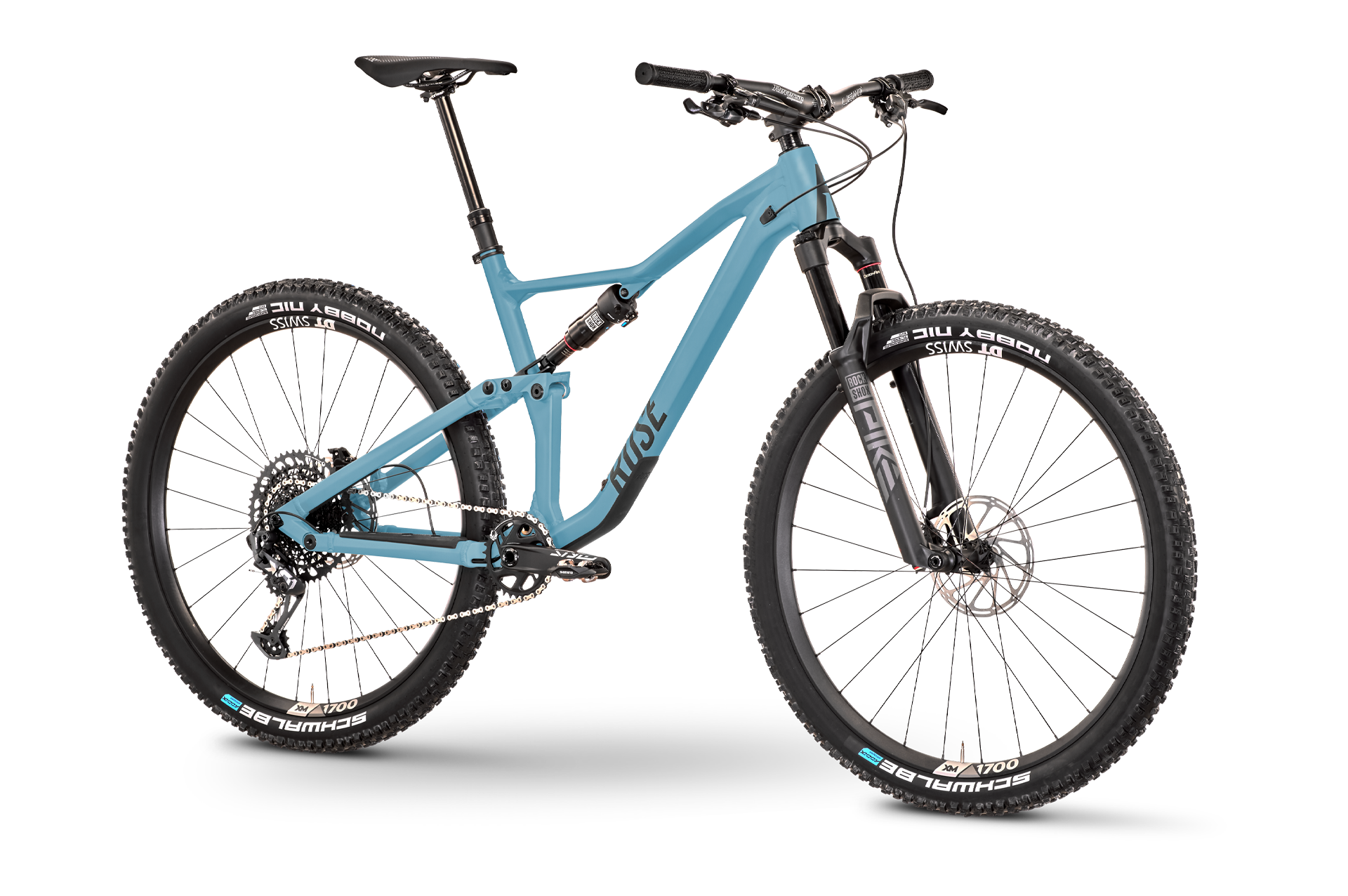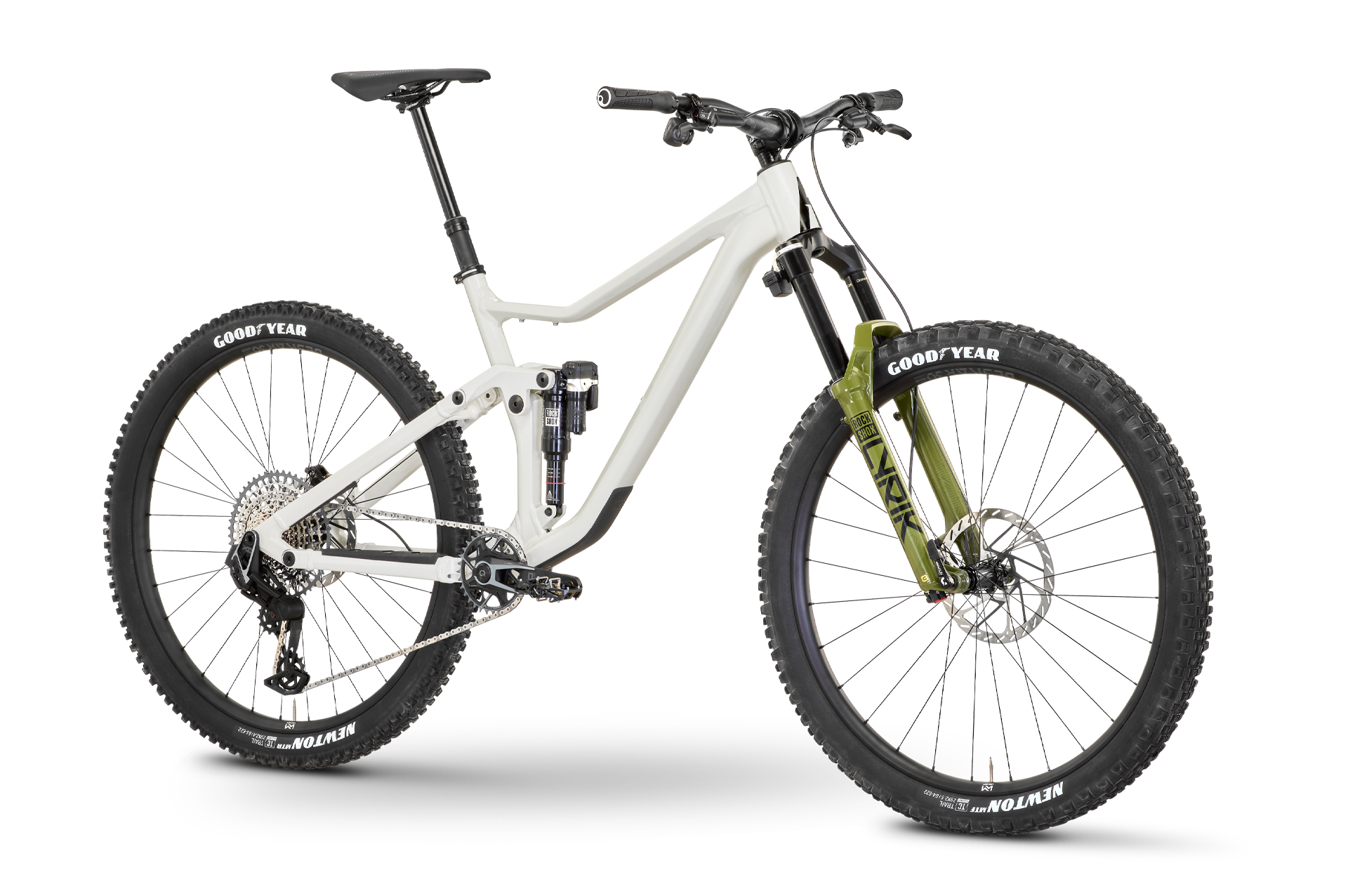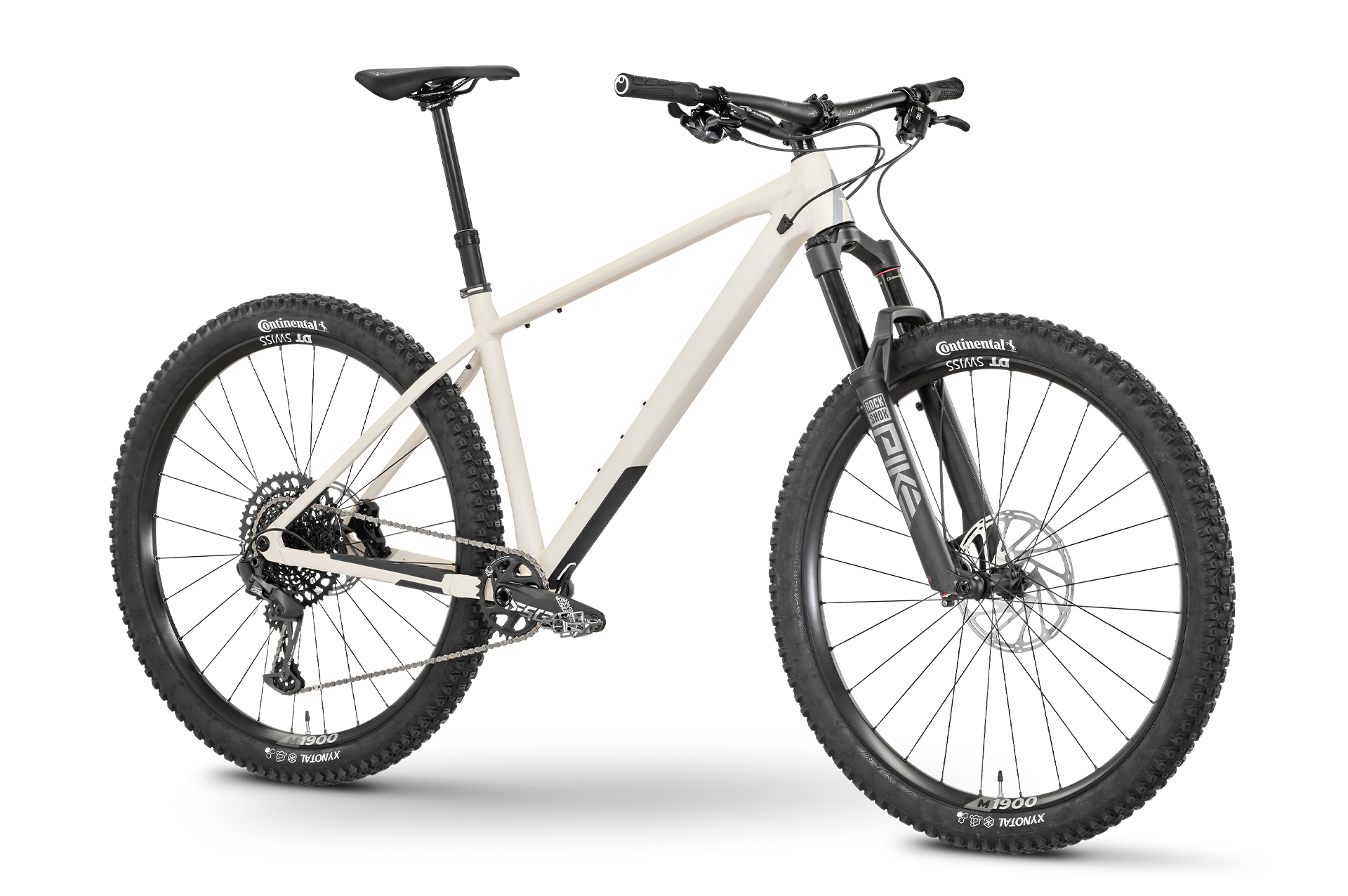Trail
Trail
MTB Trail – which bike suits you best?
Bonero
from 1,299.00 €
from 13.4 kg
Aluminium
Suspension fork (140 mm travel)
Marzocchi / RockShox
–
–
12 gears (1x12)
SRAM / Shimano
Aluminium 27,5" / 29"
Sunringlé / DT Swiss
Ground Control
from 1,599.00 €
from 13.7 kg
Aluminium
Suspension fork (120 mm travel)
RockShox
Rear air shock (120 mm travel)
RockShox
12 gears (1x12)
SRAM / Shimano
Aluminium 29"
Sunringlé / DT Swiss
Root Miller
from 2.199 €
from 15.2 kg
Aluminium
Suspension fork (160 mm travel)
RockShox
Rear air shock (150 mm travel)
RockShox / FOX
12 gears (1x12)
SRAM / Shimano
Aluminium 29"
Sunringlé / DT Swiss / Newmen
Consultation
Do you need help?
Trail mountain bikes
- Intended use: both tours and more demanding trails in mountainous terrain
- Suspension: 130mm to 150mm, Hardtail or Fully, built robust, but as light as possible
Trail or Enduro – What's right for me?
To decide which bike is right for you, you should think about where and what you mainly ride. Here are some criteria for trails and riding style to help you decide between trail and enduro.
Trail
- Forest paths
- Single trails
- Mountain tours
- Rather small to moderate jumps and drops
- Relaxed tours without racing ambitions focusing on riding fun, playful riding style
- Single trails
- Downhill trails
- Downhill trails
- Less focus on climbing
- Focus on fast and technical descents
Features of the bikes
In general, trail bikes tend to be equipped with lightweight components that are appropriate for their intended use.
The frame – hardtail or fully?
Both frame shapes can be found among trail bikes. "Hardtail" and "Fully" refer to two different types of mountain bikes, which differ mainly in their suspension:
Hardtail MTBs
The hardtail has a suspension fork at the front and is particularly versatile. It is suitable to learn the basics of riding technique – only the front wheel has suspension.
- Uncomplicated and low-maintenance
- More lightweight than most fullys
- Often cheaper to purchase
The fully, as the name suggests, is full-suspension – it has a suspension fork at the front and a shock in the rear dropouts. Both the front and the rear wheel have suspension.
What the Fully can do:
- More comfort and riding performance for the intended use
- More traction and stability for higher speeds downhill and better control in challenging terrain
- Hardtail:
A hardtail mountain bike only has suspension on the front fork, while the rear wheel has no suspension (hence "hard").
Advantages:
- Efficiency: Due to the simpler design, hardtails are often lighter and have fewer moving parts, which leads to a more efficient power transfer from the rider to the bike. This is particularly useful when riding uphill or on slippery trails.
- Low maintenance: Fewer moving parts often mean less maintenance and lower costs.
- Price: Usually, hardtails are cheaper than fullys with similar specifications.
- Versatility: Suitable for cross-country (XC) and trail riding, where efficiency and direct power transfer are important.
- Fully (full suspension):
A fully mountain bike has both suspension on the front fork and suspension on the rear frame (hence "fully" for fully suspended).
Advantages:
- Comfort and control: Provides better damping on uneven terrain, resulting in a more comfortable and controlled riding experience. This is particularly important on technically demanding trails and downhill routes.
- Traction: The suspension on the rear wheel helps to improve contact with the ground and increase traction, which is particularly beneficial on slippery or steep tracks.
- Handling: Better handling of obstacles thanks to the additional suspension at the rear, resulting in a more stable ride.
- Adaptability: Suitable for more demanding terrain such as downhill, enduro or all-mountain, where handling and damping are crucial.
The choice between a hardtail and a fully therefore depends on your preferred riding conditions and riding style. Hardtails are often a good choice for beginners or for riders who mainly ride on flatter trails or for training, while fullys are designed for riders who need more comfort, traction and control on technically demanding trails.
Trail
- Lighter
- Steeper head angle → More manoeuvrable steering behaviour on narrow single trails/li>
- Steeper seat angle → Good power transfer when pedalling
- Shorter wheelbase → More playful riding experience
- Lower bottom bracket → Stable riding behaviour in bends
Wheels, tyres and tyre size: 27.5” or 29”?
27.5" tyres can give your bike a more playful and agile ride, especially on tight trails or in bends, while 29" wheels provide a very sure-footed feel, especially when things get rough and fast. Your body height can play a role, as a wheel that is too big can appear cumbersome and be harder to control.
Rims
Lighter rims are more likely to be found on trail bikes because they have to take fewer hard knocks and, together with the lighter add-on parts, ensure the good climbing characteristics of the bikes.
Tyre casing
The lighter tyre casings of the trail bike are a little more susceptible to punctures when the terrain gets rougher, but give your bike a lively and agile ride feel because you accelerate noticeably faster.
Trail
- Lighter carcass → Lighter tyre
- Finer tread → Better centre tread = less rolling resistance
- Narrower tyres → Less rolling resistance
- Harder rubber compounds → More durable
Suspension
The suspension of a mountain bike is an essential component that significantly influences the riding characteristics and comfort of the bike. It mainly consists of the suspension, which ensures that the bike can absorb shocks and bumps on the trail. There are fundamental differences between hardtail and fully mountain bikes:
Hardtail
A hardtail mountain bike only has suspension on the front fork, while the rear wheel is rigid.
- Components of the suspension on a hardtail:
- Suspension fork: The suspension fork is located at the front of the bike and consists of two fork legs that hold the front wheel axle. It is equipped with a suspension system based on either steel spring or air suspension and also has a damping system that controls the rebound of the spring.
- Travel: The travel typically varies between 80 mm and 140 mm, depending on the intended use (e. g. cross-country, trail).
- Setting options: Many suspension forks offer adjustment options for the compression (how quickly the suspension compresses) and the rebound (how quickly it extends), as well as the option to adjust the preload on air suspension forks.
Fully (full suspension)
A fully mountain bike has suspension on both the front fork and the rear part of the frame.
- Components of the suspension on a fully:
- Suspension fork: As with the hardtail, but often with more travel (120 mm to 200 mm), depending on the intended use (e.g. trail, enduro, downhill).
- Rear suspension: Consists of a shock and a rear triangle, which can come in various designs (e.g. four-link, single-link).
- Rear Shock: The rear shock can also be fitted with steel or air springs and offers various adjustment options for compression and rebound.
- Travel: The rear suspension travel varies, usually between 100 mm and 200 mm, depending on use.
Brakes
Disc brakes are generally distinguished between the size of the rotors, i.e. the brake discs, and the number of pistons in the brake calliper. In general, the larger the brake disc, the more braking force is converted. On trail bikes, the rotors are usually 180 mm to 200 mm in size and the brake callipers have two or four brake pistons.
Drivetrain
The most common drive system for mountain bikes is the singlespeed derailleur. You shift all gears on the cassette on the rear wheel and only need one chainring on the crank.
Advantages of the singlespeed drivetrain:
- Lower weight due to fewer components
- Simple, intuitive operation – one shifter (or shift lever) for all gears
- Less error-prone and high-maintenance
- High gear range of up to 520% – covers both very low and very high gears
Seat post
The dropper seatpost offers you a number of advantages, especially when you're heading off-road. That’s why the ROSE trail bikes are fitted with a so-called Vario seat post as standard.
- Can be lowered without dismounting or stopping using a lever on the handlebar
- Creates freedom of movement and safety on steeper or rough terrain and when jumping
- Intuitive operation
The ROSE Trail Bikes
Bonero – the trail hardtail for maximum versatility
The Bonero is a trail hardtail with an aluminium frame, a dropper seat post and a singlespeed drive system. These properties perfectly complement its versatility and robustness:
- Aluminium frame: Offers a good balance between stability and weight, ideal for various trail conditions.
- Dropper seat post: Allows the rider to quickly adjust the saddle height, which is particularly advantageous on steep descents.
- Singlespeed drive: Reduces weight, simplifies operation and improves the reliability of the drive system.
The Bonero is versatile and offers both beginners and advanced riders an optimum balance of downhill fun and touring suitability. With 140 mm of travel, aggressive geometry and maximum versatility, it's perfect for improving your skills on the bike and having fun on every adventure.
Ground Control – the versatile all-rounder for fun on tours and trails
The Ground Control is a versatile fully with an aluminium frame, a dropper seat post and a singlespeed drive system that is optimally designed for touring and trail fun:
- Aluminium frame: Offers a good combination of strength and weight for different types of terrain.
- Dropper seat post: Enables quick adjustments to the saddle height, particularly useful on technical descents.
- Singlespeed drive: Simplifies operation and ensures reliable shifting performance.
The Ground Control is characterised by a balanced geometry that combines excellent climbing characteristics with agile and playful handling on the trail. With 120 mm travel at the front and rear and the roll-over characteristics of the 29-inch tyres, it offers sufficient control and traction for more demanding terrain and rough descents. This makes it the ideal companion for epic tours and maximum riding fun on a wide variety of routes.
Root Miller – made for extreme lines in technical terrain
The Root Miller is a robust fully with an aluminium frame, a dropper seat post and a singlespeed drive system that is specially designed for challenging lines in technical terrain:
- Dropper seat post: Allows you to adjust the saddle height quickly and easily, ideal for steep descents and technical passages.
- Singlespeed drive: Simplifies operation and improves the reliability of the drive system.
The Root Miller impresses with 150 mm travel on both the front and rear axle, which ensures comfort and control on rough terrain. The geometry is designed for downhill fun, but also enables efficient pedalling uphill thanks to the steep seat angle and the supportive platform damping. These features make the Root Miller an excellent choice for riders who love technical terrain and challenging descents.
)
)
)
)
)
)